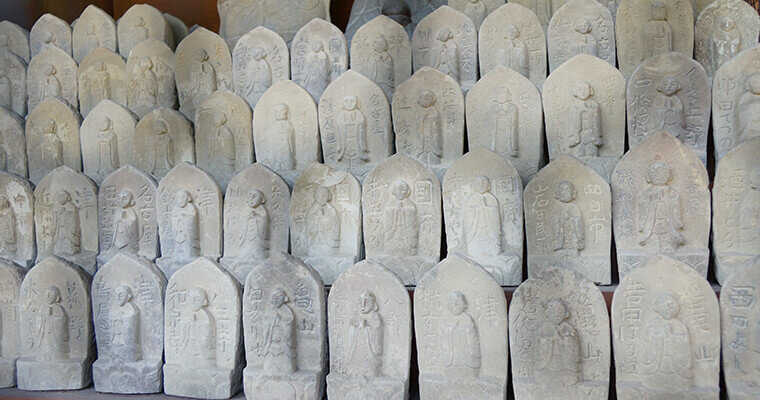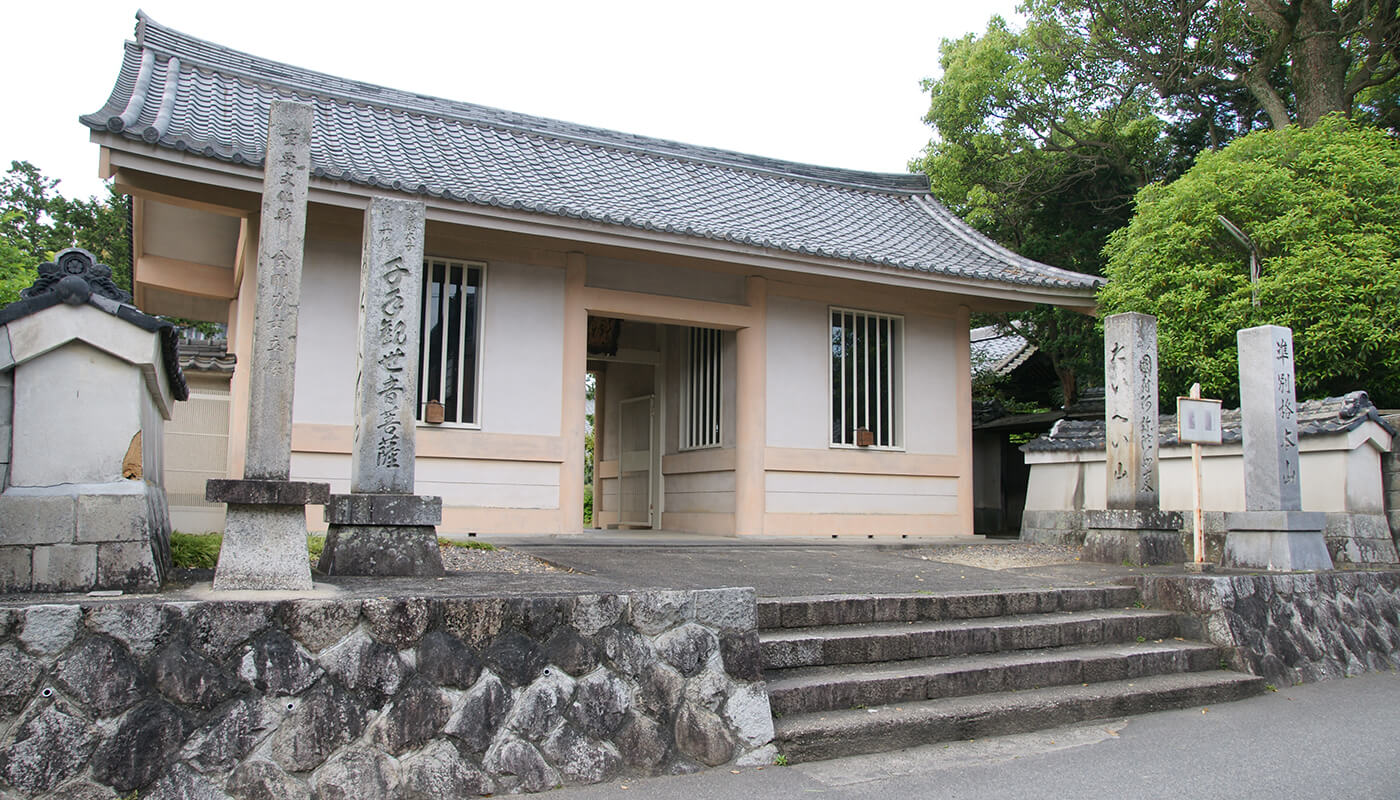Number 18Funan-ji temple
History of the temple
Funan-ji temple was founded by a famous politician and promoter of Buddhism – Prince Shōtoku (574-622). In the 9th Century it became a special class sub-temple of Ninna-ji and changed its affiliation to Omuro branch of Shingon school of Buddhism.
Since the Tenshō period (1573-1592) Funan-ji exists as a merged temple of two other ones. The first was called Taiheizan Muryōju-ji. Its main statue was Buddha Amida (Buddha of Infinite Light) also called Kō Amida (Amida of Kō). It was barely saved from being burned during the local war. The second temple was called Fudarakuzan Kannon-ji and it stood at the top of the Mount Kannon. During the war its buildings were burned down and only the Main Statue of Kō Kannon (also called Uedera Kannon) was saved. It was later moved to Taiheizan Muryōju-ji and the two temples merged in to one. The mountain name and the temple name were combined and so the current temple’s name Taiheizan Funan-ji was created. For that reason Funan-ji has two main statues in two separate buildings standing beside each other: Senju Kannon (Thousand-Armed Kannon) enshrined in Kannon Hall, and Buddha Amida enshrined in Amida Hall.
During the Edo period (1603-1868) all generations of the Lords of Kameyama Castle were devoted believers and every year they offered 750kg (1653lb) of rice to the temple.
Acording to the legend Taiheizan Muryōju-ji was founded by Prince Shōtoku after he had a divination while praying at Ise Shrine for a victory in a battle. In Kamakura period (1192-1333) a monk named Kakujō from Saidai-ji temple in Nara had a divination while praying at Ise Shrine. When he asked the Goddess Amaterasu for her will, he was told to visit this temple and pray in front of the Buddha Amida. When he did as he was told he found that the statue of Kō Amida in Muryōju-ji is the only true manifestation of Goddess Kannon. Since that day he became a devoted worshiper of this Amida.
Fudarakuzan Kannon-ji was also founded by Prince Shōtoku. The Main Statue of this temple is Senju Kannon which is also known as Kō Kannon or Uedera Kannon. Two statues of her attendants stand on both sides: elegant Bishamon (God of Treasure, Wealth, & Warriors) and Battle Victoroius Jizō (Bodhisattva who looks over travelers and the underworld). From far and near many people come to pray to Goddess Kannon of this temple. It is believed that she cures sickness, expels bad luck, invites good fortune, grants safe childbirth and in older days brought luck in silkworm rising.
Seiyōzakki
Fudarakuzan Funan-ji stands in Kō, in a distance of 2 ri east from Kameyama. The Main Statue is Senju Kannon. It is a temple number 18 of Ise Pilgrimage.
Pine trees changing colors at the peak of Mount Uedera. Sound of the wind shaking the pine trees informs that the autumn has come.
Fudarakuzan Funan-ji
The main statue of this temple is Senju Kannon which is also known as Kō Kannon or Uedera Kannon. Two statues of her attendants stand on both sides: elegant Bishamon and Battle Victoroius Jizō.
It is believed that this temple and Taiheizan Muryōju-ji were both founded by Prince Shōtoku. He wanted to spread Buddhism in Japan but he had an opponent in a high-ranking head of the Mononobe clan Mononobe no Moriya (died 587). Prince Shōtoku prayed at the Ise Shrine wishing for Mononobe’s surrender. He received a divination saying: If you want to spread and make Buddhism flourish, you should first start with building a first building of the temple in this province and devote yourself to prayer. The Prince traveled across Ise province and when he came to this land, he received a divination from Uho-dōji (divine rain-making boy = Goddess Amaterasu) saying: I was waiting for you. Make this southern mountain a land deeply connected to Goddess Kannon and when you enshrine a Senju Kannon here, certainly any wish will be granted. He immediately started to search for a sacred tree and when he found one, he carved a 3.94m (12ft11in) high Senju Kannon out of it. Then he built a complete seven-structured temple compound and enshrined the statue inside. The mountain name of the temple was taken from the mythical Kannon’s Pure Land called Mount Fudaraku (Potalaka). The temple’s name Funan-ji originally means the temple south of Kokufu (provincial office). In ancient times there used to be a Kokufu (provincial office) in the northern area of this land. Because the temple was standing south from it, the location became its formal name. Prince Shōtoku decided to enshrine a statue of Marishiten (Goddess of the Warrior Class, Wealth and Entertainers) as a protector of this temple. Before the battle with Mononobe no Moriya, he gave Kannon’s protective talismans to all of his soldiers wishing for battle victory and expelling of bad luck. In the end he won the battle and thanks to this achievement, the temple became an official place where monks directly prayed for Empress Suiko (554-628).
Within the temple’s grounds there is a pond called Kannon ike (Kannon pond) or Tennin yougou ga ike (A pond where a heavenly being shows itself for a moment). In front of the Kannon Hall grows a pine tree called kishi no matsu (pine of the shore). According to the legend it was planted by Prince Shōtoku.
It is believed that the main statue of the temple cures sickness, expels bad luck, invites good fortune, grants safe childbirth and in older days brought luck in silkworm rising. Even now many people from far and near come to pray and get their wishes granted.
Taiheizan Muryōju-ji
According to the legend the temple was built by Prince Shōtoku, who came to pray at Ise Shrine for a victory in a conflict with Mononobe no Moriya. He received a divination which ordered him to build this temple. Later it became a praying place for Emperor Shōmu (701-756). He ordered Gyōki (668-749), a famous monk who traveled around Japan to preach to commoners, to expand the temple. During the Kōnin period (810-824) Kūkai came to this temple for a short visit while traveling and preaching around the country. He was so astonished with the spiritual power of the main statue of Buddha Amida, that he conducted a 17 day long grand memorial service ritual in front of it. It was said that: The visiting crowds of monks and laity, men and women were so numerous that they looked like a clouds and haze.
In the 13th Century, during the reign of Emperor Gouda (1274-1296), a monk from Saidai-ji temple in Nara called Kakujō stayed in Ise Shrine for prayer. He decided to do 100 days prayer and ask: I’d like to hear the will of the Goddess Amaterasu. On the 99th night Goddess appeared in his dream and told him: Wait until dawn then come to Futami ga ura bay, I will show myself to you. He did what he was told and when he reached Futami ga ura bay at dawn, he saw a 3m (9ft10in) long golden serpent appearing on the ocean’s surface. Kakujō shouted: people of this endless degenerate world will fear you and it will be hard for them to have faith. He took off his monk’s stole made from bamboo fabric and threw it at the serpent. The serpent disappeared in the depths of water. He went back to the Ise Shrine and devoted himself to prayer again. In the middle of the 17th night of continuous prayer he heard a voice from the sky saying: North from here there is a village called Kō in which a temple called Taiheizan Muryōju-ji stands. Buddha Amida with his two attendants who are worshiped there are my true manifestations. By praying to that statue you will pray to me. Kakujō rushed to Muryōju-ji. Together with the abbot of the temple Ryōhan they invited common people and chanted Daihannya Sutra (Large Perfection of Wisdom Sutra). When both of them opened the altar to pray to the hidden statue they noticed that the statue had Kakujō’s bamboo stole, the one he threw at the divine serpent in Futami ga ura bay, hanging on it. When the participants of the sutra chanting heard what happened in Futami at dawn, they understood that this Buddha Amida is truly the only true manifestation of Goddess Amaterasu and decided to deeply devote themselves to prayer. News about this miracle spread quickly and this is how Amida of Kō became famous.

Outline
-
Honorific name
Taiheizan
-
Temple's name
Funan-ji
-
Sect
Shingon Omuro branch
-
Religious service
Senju Kannon
(Thousand-Armed Kannon)

Details
-
Address
Mie Prefecture Suzuka Ko-cho 2548
-
Phone number
059-378-0539
-
Stamp place
Temple's counter
-
Opening hours
8:00 - 17:00
-
Official website




